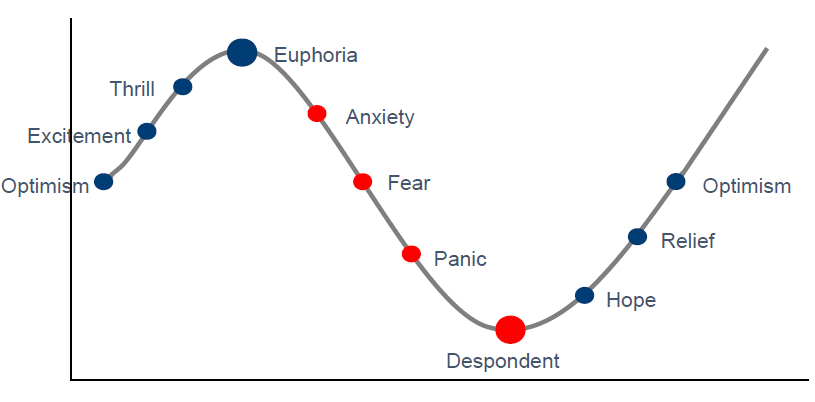At this time of year, we often say, “Happy New Year!” But is this how you are feeling? Are you really feeling happy? Or would you describe your emotions another way? How would your work colleagues, family or friends describe their feelings?
Coming into a new year, we can feel happy and hopeful. But after the experiences of the past year, whether as a global community or in our individual circumstances, there could be a variety of feelings that you may have.
Universally when we go through change, there can be identified phases through which we pass. At the start there is a time of “forming” as we go into the change. Then “storming” as we adjust to the change. Followed by “norming” and then “performing” as we embrace the change and move to a new level. Each of these levels can have associated emotions.
Emotions in Change
A colleague of mine, Doug Brown of Paradigm Associates, shared this diagram that I thought was very helpful:

This diagram helps to give labels to the feelings that we may be experiencing as we go through change.
Why is this important? Research has shown that your top performers are self-aware and authentic. Being self-aware of our feelings is critical. To have high emotional intelligence, and so then to lead well, you need to pay attention to your feelings. As Bradberry and Greaves share in their book, Emotional Intelligence 2.0, awareness of your emotions allows you to direct your behaviors in positive directions.
Emotions can cloud our thinking. For example, fear can lead to some people becoming paralyzed and for others to lash out without fully thinking something through. By acknowledging our emotions, it gives us space to be proactive instead of reactionary. We can explore and be reflective about the feeling that then allows for self-control with clarity of decisions and behaviors.
Another benefit of being aware of our emotions is that it can lead to higher authenticity. It allows you to be intentional about who you are and how you act. This is powerful because people can sense our genuineness. When this is displayed, it builds trust and influence which is foundational for strong teams.
How to Apply
So, what emotions are you experiencing on the chart above? Put a label on the feelings. Take the time to reflect on it. You may find journaling or talking to a trusted person to process as helpful.
Next, use this as an exercise with your team. Ask them which emotions they are experiencing? Allow time for sharing and reflection. How is this emotion impacting them personally and at work?
For some this may seem like a risky exercise. What will happen when these emotions are revealed? However, the emotions are there whether you talk about it or not. The best action is to acknowledge them, instead of covering them up and it leading to reactionary behaviors. You may also find that this is helpful with building trust in your team.
Please share with me how you use this diagram. And blessings as you go into this new year.
